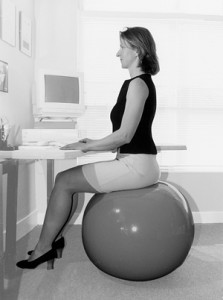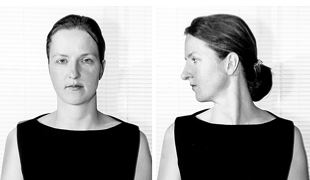Back strengthening exercises should include stomach exercises. Why? Most people who suffer from back problems have a muscle imbalance between the muscles of the front of their body and the muscles of the back. Their stomach muscles tend to be week and lacking tone while the muscles of the back tend to be tight. So, if you want to exercise for your back it is important to do stomach ecerises, too.
In the previous posts you were introduced to simple stretching, mobility and strengthening exercises. Please be sure to review the general guidelines about back strengthening exercises and stomach exercises before continuing with the next set of exercises.
Stomach Exercises while sitting:
Start by sitting upright on the ball.
1. Tighten the muscles in your stomach by pulling your stomach in. Clench the cheeks of you buttocks together and hold these muscles tight throughout the exercise. The buttocks muscles are an important part of your back muscles. Engaging them by clenching them is an important part of any back strengthening exercise program. Make sure you keep breathing throughout theses stomach exercises.
2. Start rolling the ball forward as you curve your lower back, moving your lower back towards the ball. Make sure you curve the lower back onto the ball as oppose to leaning your upper back backward.
3. Bring your upper body back a little bit. Hold this position for 5 to 10 seconds while breathing normally.
• Repeat 3 to 5 times
Variation for more stomach strength:
To make above exercise more strenuous, you can let go of the table top and bring your hands to the shoulders. To push it even harder bring the hands behind the head and/or straighten the arms towards the ceiling. As before ensure you are breathing normally throughout the exercise.
• Repeat the exercise 3 to 5 times









